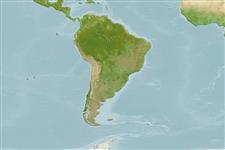Gastropoda |
Littorinimorpha |
Cypraeidae
Environment: milieu / climate zone / depth range / distribution range
Ecology
Demersal; depth range 0 - 30 m (Ref. 94005). Subtropical
Southeast Pacific: Easter Island and Sala y Gómez. Endemic to Easter Island.
Length at first maturity / Size / Weight / Age
Maturity: Lm 2.9, range 2 - 4.01 cm Max length : 3.5 cm ShL male/unsexed; (Ref. 8763)
Under rocks in 0.6-0.9 m along rock shoreline and in tide pools; also in holes
and crevices at or just below tide line (Ref. 87884).
Life cycle and mating behavior
Maturity | Reproduction | Spawning | Eggs | Fecundity | Larvae
Egg mass incubated and protected by the female under her foot (Ref. 93583). Female: stage F1 (initial maturity) - gonad yellow, gonadal acini with active initial oogenesis, germinal line with small oogonia and initial previtellogenic oocytes bearing germinal vesicle; stage F2 (peak maturity) - gonad yellow, gonadal acini with complete oogenesis, germinal line filled with free and very large vitellogenic oocytes; stage F3 (regression or post-gamete release, with occasional gonadal recovery) - gonad cream or brown, gonadal acini contracted. Male: stage M1 (initial maturity) - gonad orange, acini with early germinal line, spermatogonia and spermatocytes predominate, penis present; stage M2 (peak maturity) - gonad orange, complete germinal line in gonadal acini; elongate spermatids arranged in tiers filling the acini lumen; stage M3 (regression or maximum release) - gonad translucent, gonadal acini occupied by few residual spermatids of a prior release. The species is reproductively active year-round. More than one male could compulate with a female.
Heiman, E. 2007 List of living cowry taxa Version 01. Personnal communication (12/08). (Ref. 8761)
IUCN Red List Status
(Ref. 130435: Version 2025-1)
CITES status (Ref. 108899)
Not Evaluated
Not Evaluated
Threat to humans
Human uses
Fisheries: commercial
| FishSource |
Tools
More information
Trophic EcologyFood items (preys)
Diet composition
Food consumption
Predators
Population dynamicsGrowthMax. ages / sizesLength-weight rel.Length-length rel.Length-frequenciesMass conversionAbundance PhysiologyOxygen consumption
Human RelatedStamps, coins, misc.
Internet sources
Estimates based on models
Fishing Vulnerability
Low vulnerability (10 of 100).
